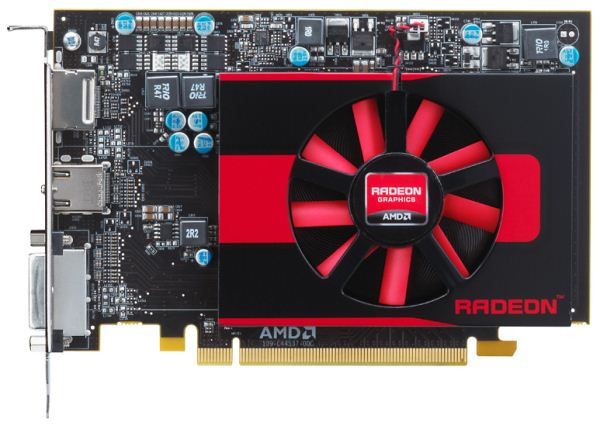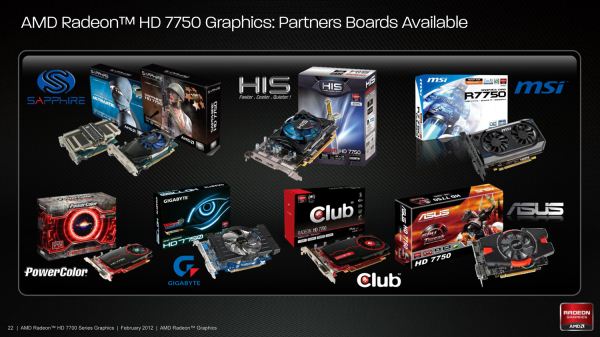AMD Radeon HD 7750 & Radeon HD 7770 GHz Edition Review: Evading The Price/Performance Curve
by Ryan Smith & Ganesh T S on February 15, 2012 12:01 AM EST- Posted in
- GPUs
- AMD
- HTPC
- GCN
- Radeon HD 7000
Meet the Radeon HD 7750
We’ll kick things off as always with a look at the cards themselves, starting with the Radeon HD 7750. As we alluded to before, this is the de-facto replacement for the Radeon HD 6670, and you only have to take one look at the card to understand why.
AMD’s reference design for the 7750 is virtually identical to the full-profile 6670 or the FirePro V4900, which should come as no surprise given that all of these cards are or were AMD’s top sub-75W cards in their respective markets. As a result, like those cards the reference 7750 is a full-profile card featuring a single-wide active cooler.
As the 7750 is AMD’s cheapest Southern Islands card, you won’t find much else on the card to speak of. As a sub-75W card it doesn’t need external power, and cementing its position as the replacement for the 6670 there isn’t a CrossFire connector on the card. For RAM the card uses 4 256MB Hynix GDDR5 RAM chips, which are rated for 5GHz. The card is 6.57” long overall, the same length as the 6670.

Meanwhile for display connectivity, AMD is once again using the same configuration as we’ve seen in their other full-profile mainstream cards. This means 1 DL-DVI port, 1 HDMI port, and interestingly enough 1 full size DisplayPort. The latter is particularly odd, as the rest of the Southern Islands lineup is exclusively miniDP and in the last year miniDP has become the de-facto port for source devices. AMD has told us that there’s no specific reason that they’re using a full size DisplayPort here, and we believe it’s largely being done out of maintaining consistency with previous products. With that said we’d rather see miniDP here – even if it’s just 1 port instead of 2 – so that it’s consistent with the rest of the 7000 series.
Finally, as is customary for a midrange product launch, everyone is doing semi-custom cards right off the bat. Everyone will be using AMD’s PCB for now, while none of the 7750 cards in the press materials sent to us will be using AMD’s cooler. Instead we’ll see a range of designs, from similar side-wide designs to the more common double-wide designs, and even a passively cooled design from Sapphire. Much like the 6670 the HTPC use case for the 7750 is rather obvious, so we suspect that we’ll see more passive and perhaps even some low-profile cards in the future.


















155 Comments
View All Comments
kallogan - Wednesday, February 15, 2012 - link
HD 6850 is still the way to go.zepi - Wednesday, February 15, 2012 - link
So basically in couple of generations we've gone4870 > 5770/6770 > 7770
Chip size
260mm2 > 165mm2 > ~120mm2 chip.
Performance is about
100 > 100 > 120
Power consumption in gaming load according to Techpowerup (just graphics card):
150W - 108W - 83W
And soon we should have 1 inch thick laptops with these things inside. I'm not complaining.
silverblue - Wednesday, February 15, 2012 - link
Good point. One thing I think people forget is that smaller processing technologies will yield either better performance at the same power, or reduced consumption at the same performance... or a mix of the two. You could throw two cards in dual-GPU config for similar power to one you had two years back, and still not have to worry too much if CrossFire or SLi doesn't work properly (well, if you forget the microstuttering, of course).cactusdog - Wednesday, February 15, 2012 - link
WHy is the 6770 left out of benchmarks?? Isnt that odd considering the 7770 replaces the 6770? I really wish reviewers would be independant when reviewing cards, instead of following manufacturer guidelines.Markstar - Wednesday, February 15, 2012 - link
No, since the 6770 is EXACTLY the same card as the 5770 (just relabeled). So it makes sense to continue using the 5770 and remind AMD (and us) that we do not fall for their shenanigans (sadly, many do fall for it).gnorgel - Wednesday, February 15, 2012 - link
For your 6850. It should sell a lot better now. Maybe they really stopped producing it and need to get rid of stocks. But when it's sold out almost anyone should go for a gtx 560, 7% more expensive and 30% faster.The only reason to buy a 7770 now is if your powersupply can't support it and you would have to get a new one.
duploxxx - Wednesday, February 15, 2012 - link
by the time the 6850 is out of stock the 78xx series are launched which will knock out 560don't understand what evryone is complaining about, its faster then the 57xx-67xx series, les spower. sure it's not cheap but neither are the 57-67 @ launch. Combined with old gen available and NV products a bit to expensive but this is just starting price....
akbo - Wednesday, February 15, 2012 - link
Moore's law apparently doesn't apply to graphic cards. People expectations do. People expect that every two years gpus at the same price point have double transistors and thus be faster by so. Obviously perf does not scale like so since the 28 nm shrink only has a 50% improvement from 40 nm. However that would mean a 50% improvement is expected. Imperfect scaling would mean a 40% improvement.So people expect that a card which is 20% faster than a card from 2 years ago to be 1.2/1.4 the price at launch, or an ~ 85% of the 5770 launch price in this case. That would mean that the card should retail at around $130-140 or so for the 7750 and sub-$100 pricing, like $90 or so. I expect it to be that price too.
chizow - Wednesday, February 15, 2012 - link
Moore's Law does actually hold true for GPUs in the direct context of the original law as you stated, roughly doubled transistors every 2 years with a new process node. The performance has deviated however for some time now with imperfect scaling relative to transistors, but at least ~50% has been the benchmark for performance improvements over previous generations.Tahiti and the rest of Southern Islands itself isn't that much of a disappointment relative to Moore's Law, because it does offer 40-50% improvement over AMD's previous flagship GPU. The problem is, it only offers 15-25% improvement over the overall last-gen performance leader the GTX 580 but somewhat comically, AMD wants to price it in that light.
So we end up with this situation, the worst price performance metrics ever where a new GPU architecture and process node only offers 15-25% performance increase at the same price (actually 10% more in the 7970 case). This falls far short of the expectations of even low-end Moore's Law observer estimates that would expect to see at least +50% over the last-gen overall high-end in order to command that top pricing spot.
arjuna1 - Wednesday, February 15, 2012 - link
DX11.1?? With only one true DX11 game on the market, BF3, there is literally no incentive to upgrade to this generation of cards 7xxx/kepler.Unless nvidia comes out with something big, and I mean big as in out of this world, I'll just skip to the next gen, and if AMD insists in being an ass with pricing, I'll go Ngreen when the time comes.
Now, the worrying thing is that it's becoming evident, both parties are becoming too cynical with price fixing, when is that anti trust lawsuit coming?